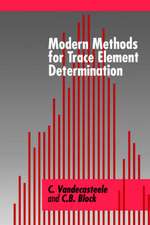Analysis and Analyzers: Volume II
Editat de Béla G. Lipták, Kriszta Venczelen Limba Engleză Hardback – 6 oct 2016
Analysis and Analyzers is an invaluable resource that describes the availability, features, capabilities, and selection of analyzers used for determining the quality and compositions of liquid, gas, and solid products in many processing industries. It is the first time that a separate volume is devoted to analyzers in the IAEH. This is because, by converting the handbook into an international one, the coverage of analyzers has almost doubled since the last edition.
Analysis and Analyzers:
- Discusses the advantages and disadvantages of various process analyzer designs
- Offers application- and method-specific guidance for choosing the best analyzer
- Provides tables of analyzer capabilities and other practical information at a glance
- Contains detailed descriptions of domestic and overseas products, their features, capabilities, and suppliers, including suppliers’ web addresses
About the eBook
The most important new feature of the IAEH, Fifth Edition is its availability as an eBook. The eBook provides the same content as the print edition, with the addition of thousands of web addresses so that readers can reach suppliers or reference books and articles on the hundreds of topics covered in the handbook. This feature includes a complete bidders' list that allows readers to issue their specifications for competitive bids from any or all potential product suppliers.
Preț: 2094.82 lei
Preț vechi: 2720.55 lei
-23% Nou
Puncte Express: 3142
Preț estimativ în valută:
400.97€ • 435.69$ • 337.03£
400.97€ • 435.69$ • 337.03£
Carte disponibilă
Livrare economică 31 martie-14 aprilie
Preluare comenzi: 021 569.72.76
Specificații
ISBN-13: 9781498727686
ISBN-10: 1498727689
Pagini: 1332
Ilustrații: 985
Dimensiuni: 210 x 280 x 46 mm
Greutate: 2.04 kg
Ediția:5
Editura: CRC Press
Colecția CRC Press
Locul publicării:Boca Raton, United States
ISBN-10: 1498727689
Pagini: 1332
Ilustrații: 985
Dimensiuni: 210 x 280 x 46 mm
Greutate: 2.04 kg
Ediția:5
Editura: CRC Press
Colecția CRC Press
Locul publicării:Boca Raton, United States
Cuprins
Analytical Measurement. Appendix.
Notă biografică
Béla Lipták was born in 1936 in Hungary. As a technical university student, he participated in the revolution against the Soviet occupation, escaped, and entered the United States as a refugee in 1956. In 1959, he received an engineering degree from the Stevens Institute of Technology. In 1962, he received a master’s degree from the City College of New York. He later studied computers at the graduate level at the Pratt Institute. In 1960, he became the chief instrument engineer of Crawford and Russell, where he led the automation of dozens of industrial plants for more than a decade. In 1969, he published the multi-volume Instrument Engineers’ Handbook, which today is in its fifth edition. In 1975, he received his professional engineering license and founded his consulting firm, Béla Lipták Associates PC, which provides design and consulting services in the fields of automation and industrial safety. Over the years, he has lectured on automation at many universities around the world, including Yale University, where he taught automation as an adjunct professor in 1987. His inventions include the transportation and storage of solar energy and the design of safe nuclear reactors. His 50+ years of professional experience include the automation of several dozen industrial plants and the publication of more than 300 technical articles (http://www.controlglobal.com/voices/liptak/) and 20+ books on various aspects of automation, safety, and energy technologies. (http://www.amazon.com/B%C3%A9la-G.-Lipt%C3%A1k/e/B001K8B0U0). In 1973, he was elected as a fellow of the International Society of Automation (ISA). In 1995, he received the Technical Achievement Award. In 2001, he received the Control Hall of Fame Award. He was the keynote speaker at the 2002 and 2011 ISA conventions. In 2012, he received the ISA’s Lifetime Achievement Award.
Recenzii
Praise for the Previous Editions
"The editor of this masterpiece, Béla Lipták, is a longtime engineering consultant, a teacher at Yale, and a fellow of the ISA. He is clearly devoted to producing a useful reference. … The book is replete with simple explicatory figures and diagrams; well-organized summaries with information on the costs, suppliers, ranges, and inaccuracies of the instruments covered; and practical tips on related subjects such as good instrument maintenance practices. … Comprehensive, practical, and well-organized, this book is highly recommended for academic libraries and engineering company libraries. It can best serve as a teaching aid for students or as a reference manual for both new and experienced practicing engineers."
—E-Streams
"Those [contributors] eventually selected are without doubt among the best. … Whether used as a textbook by inexperienced engineers or as a quick reference book for the experienced engineer, this book is set to continue to be the main reference to the instrument engineer for the next decade."
—Alan Reese, Control & Instrumentation
"I have seen nothing with the scope of this handbook."
—Roy V. Hughson, Chemical Engineering
"In our smaller universe of process control, Béla Lipták is a towering presence."
—Terrence K. McMahon, Control
"The editor of this masterpiece, Béla Lipták, is a longtime engineering consultant, a teacher at Yale, and a fellow of the ISA. He is clearly devoted to producing a useful reference. … The book is replete with simple explicatory figures and diagrams; well-organized summaries with information on the costs, suppliers, ranges, and inaccuracies of the instruments covered; and practical tips on related subjects such as good instrument maintenance practices. … Comprehensive, practical, and well-organized, this book is highly recommended for academic libraries and engineering company libraries. It can best serve as a teaching aid for students or as a reference manual for both new and experienced practicing engineers."
—E-Streams
"Those [contributors] eventually selected are without doubt among the best. … Whether used as a textbook by inexperienced engineers or as a quick reference book for the experienced engineer, this book is set to continue to be the main reference to the instrument engineer for the next decade."
—Alan Reese, Control & Instrumentation
"I have seen nothing with the scope of this handbook."
—Roy V. Hughson, Chemical Engineering
"In our smaller universe of process control, Béla Lipták is a towering presence."
—Terrence K. McMahon, Control
Descriere
This book is an invaluable resource for the selection of analyzers used to automatically determine the compositions of liquids, solids, or gases in all industries. Featuring up-to-date coverage and contributions from experts on every continent, the text discusses the advantages and disadvantages of various analyzer designs, offering application- and method-specific guidance for choosing the best analyzers. The eBook version places at the readers' fingertips thousands of web addresses of suppliers and links to further reading material, while the thorough index provides quick access to specific information.



















